Covid-19 News Updates: The Virus Has Now Killed 250,000 People in the U.S.A
Covid-19 Live Updates: The Virus Has Now Killed (250,000) People in the U.S.
A quarter of a million people have died in the U.S. from Covid-19.

Prison inmates in El Paso loaded bodies into a refrigerated truck outside the county medical examiner’s office on Tuesday. Credit…Mario Tama/Getty Images Visit More Info
The United States passed a grim milestone on Wednesday, hitting 250,000 coronavirus-related deaths, with the number expected to keep climbing steeply as infections surge nationwide. Visit More Info
Experts predict that the country that could soon be reporting 2,000 deaths a day or more, matching or exceeding the spring peak, and that 100,000 to 200,000 more Americans could die in the coming months. Visit More Info
Just how bad it gets will depend on a variety of factors, including how well preventive measures are followed and when a vaccine is introduced. Visit More Info
“It all depends on what we do and how we address this outbreak,” said Jeffrey Shaman, a Columbia University epidemiologist who has modeled the spread of the disease. “That is going to determine how much it runs through us.” Visit More Info
Back in March, when the virus was still relatively new and limited mainly to a few significant pockets like New York, Dr. Anthony S. Fauci, the top infectious disease expert in the country, predicted that it might kill up to 240,000 Americans. Visit More Info
It has now passed that mark, with no end in sight.
Since the very beginning, preventive measures like wearing masks have been caught up in a political divide, and that remains the case today, as the Trump administration resists beginning a transition of power to President-elect Joseph R. Biden Jr. and cooperating on a pandemic strategy. Visit More Info
New vaccines may begin to have an impact next year, experts said, and for now, developments in treating the disease as well as a younger population getting infected mean that far fewer people who are admitted to hospitals are dying. Infections are also being diagnosed earlier, which helps combat it. Visit More Info
The deadliest day of the pandemic in the United States was April 15, when the reported daily toll hit 2,752.
There is always a lag in deaths, compared with the rate of infection and hospitalizations, and with the latter measure now hitting records every day — 76,830 Americans were hospitalized on Tuesday, according to the Covid Tracking Project — the death toll is certain to go on rising. Visit More Info
Covid-19 deaths have continued their bleak march with little respite throughout the year.
By March 24, a little over a month into the pandemic, 50,000 people had died. That number doubled to 100,000 by May 27 and added another 50,000 within two months, by July 29. Two months later, on Sept. 22, the total reached 200,000. Visit full news
Toward the end of the summer, the number of cases being reported daily in the United States eased, after a brief spike in July. But they have been soaring again since the beginning of November.
On Sept. 22, there had been somewhat more than 6.9 million total cases in the United States, according to a New York Times database. As of today, there have been more than 11.5 million. See More
The combination of the onset of winter, fatigue with preventive measures, holiday travel and gatherings as well as the patchwork of responses across all 50 states is expected to drive that number still higher.
“We have a lot of people who have not been infected with this yet,” said Dr. Shaman. “If you get complacent, the virus does not care. It is just going to come back.”
Tracking the Coronavirus ›
United StatesOn Nov. 1714-day
changeTrendNew cases159,508+79%New deaths1,583+38%WorldOn Nov. 1714-day
changeTrend528,803+14%9,666+30%
Where cases per capita are highest
N.D.S.D.IowaWyo.Minn.Neb.Wis.Mont.Ill.Kan.UtahInd.Colo.AlaskaMo.
U.S. hot spots ›
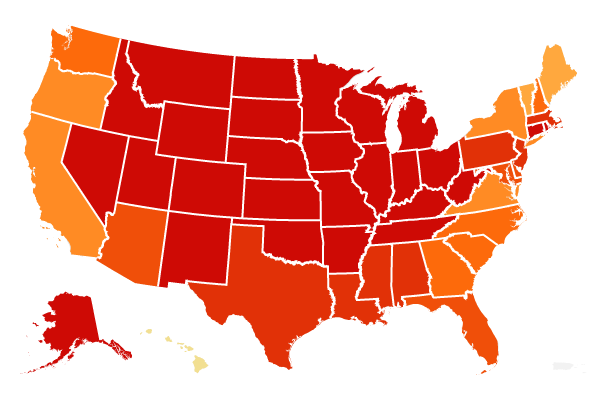
College cases ›
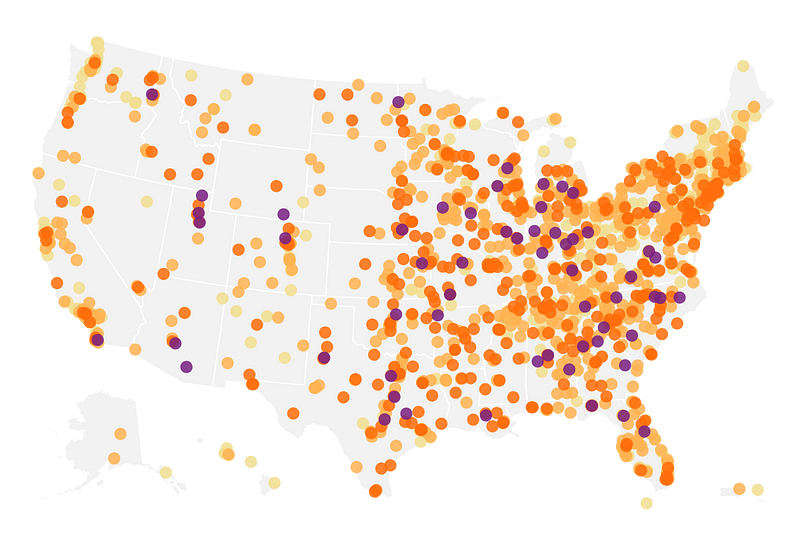
Worldwide ›
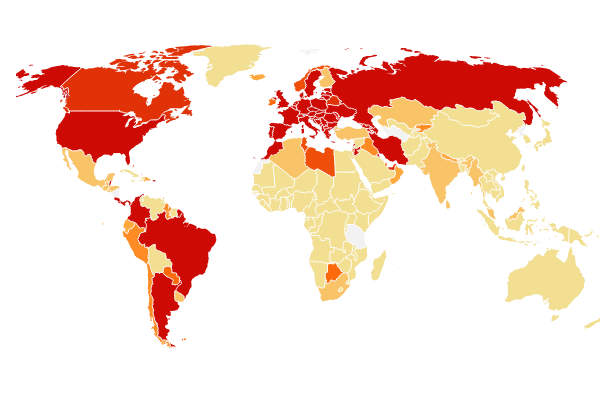
N.Y.C. will shutter public schools on Thursday as virus cases increase.
Video
TRANSCRIPT
0:00/1:44
New York City Schools Will Close Thursday, de Blasio Says
Mayor Bill de Blasio said the New York City public school system would shut down a second time after the city reached a 3 percent coronavirus test positivity rate over a seven-day rolling average.
Unfortunately as of today, on our seven-day rolling average for coronavirus positivity, New York City has hit exactly 3.0 percent. And as a result, we do need to close our schools for the coming days. No one is happy about this decision. We all, in fact, are feeling very sad about this decision because so much good work has been put into keeping the schools opened — and opening them up to begin with, let’s start there, opening the schools when almost no other major school system in America opened, making them so safe. But we set a very clear standard. And we need to stick to that standard. And I want to emphasize to parents, to educators, to staff, to kids, that we intend to come back and come back as quickly as possible. We are working right now with the state of New York. And that was a lot of what we talked about this morning. I had a number of conversations with the governor, and our teams have been talking throughout the morning on exactly what it would take to come back and bring our schools back quickly, and it will be a higher standard. I want that to be clear, we have a stringent health and safety standard right now. We’re going to have to raise that up even higher to be able to bring our schools back. But that’s exactly what we intend to do. The state, the governor and I spoke several times. Obviously he has laid out some of the additional measures the state likely will be taking quite soon in New York City, additional restrictions across the board that will affect a number of different industries, a number of different parts of life of this city because we are dealing with a bigger problem. All over New York City and state, all over the country, the region. We have to do more to fight back this second wave. So the state has made very clear, additional restrictions are coming and coming soon.
https://jfine6225.medium.com/covid-19-live-updates-the-virus-has-now-killed-250-000-people-in-the-u-s-9a5d7984633a
https://asqweqweas.over-blog.com/2020/11/covid-19-live-news-the-virus-has-now-killed-250-000-people-in-the-u.s.html
https://newsjapanin.blogspot.com/2020/11/covid-19-news-updates-virus-has-now.html
https://sites.google.com/view/covid-19-live-updates-the-viru
https://movielovers.substack.com/p/live-news-updates-covid-19-the-virus
https://steemit.com/news/@lisa1234/covid-19-live-updates-the-virus-has-now-killed-250-000-people-in-the-u-s-a-2020
https://newsfortodays.hatenablog.com/entry/2020/11/19/084150
https://blog.goo.ne.jp/firsteverythingme/e/120824047cd1da6e167ea9a12658cbea
1:43New York City Schools Will Close Thursday, de Blasio Says
Mayor Bill de Blasio said the New York City public school system would shut down a second time after the city reached a 3 percent coronavirus test positivity rate over a seven-day rolling average.CreditCredit…Anna Watts for The New York Times
New York City’s public school system will shutter on Thursday, the schools chancellor, Richard A. Carranza, wrote in an email to principals, in a worrisome signal that a second wave of the coronavirus has arrived. Schools have been open for in-person instruction for just under eight weeks.
“As of this morning, November 18, the City has now reached this threshold of test positivity citywide and, as a result, the DOE will temporarily close down all public school buildings for in-person learning, Thursday, November 19,” Mr. Carranza wrote shortly after 2 p.m. on Wednesday, about four hours after Mayor Bill de Blasio was scheduled to give a news conference. Mr. de Blasio confirmed the news in a tweet.
The shutdown — which was prompted by the city reaching a 3 percent test positivity rate over a seven-day rolling average — is perhaps the most significant setback for New York’s recovery since the spring, when the city was a global epicenter of the outbreak.
https://me.me/g/capmeyou-204573
https://glorioussaladwinner.tumblr.com/post/635167677505224704/dfghfgfhkhgcjfchvhnhgvb
https://www.peeranswer.com/question/5fb5afe768c9c49e6e856194
https://caribbeanfever.com/photo/albums/sdfcgvbhfghgffhffggf
https://note.com/notes/nbfae5c3535e2/paypart
https://pasteio.com/xy18VrZt6Gv8
https://onlinegdb.com/HyGhX4Xcw
https://jsfiddle.net/4n7xkurq/
https://paiza.io/projects/76OCR9ubIJmfmsPCAnXc6g?language=php
It was also a major disappointment for Mayor Bill de Blasio, who was the first big-city mayor in the country to reopen school buildings. Moving to all-remote instruction will disrupt the education of many of the roughly 300,000 children who have been attending in-person classes and create major child care problems for parents who count on their children being at school for at least part of the week.
Virus transmission in city schools had remained very low since classrooms reopened at the end of September, and the spike in cases does not appear to be caused by the reopening of school buildings.
Still, as the city chose to end in-person learning, indoor dining and gyms will remain open at a reduced capacity. Nonessential workers can continue to use public transportation to commute to offices.
That dynamic has infuriated parents run ragged by fluctuating school schedules and frustrated public health experts who have been pushing for more in-person instruction. It has also led to calls for the mayor and Gov. Andrew M. Cuomo to make keeping classrooms open their highest priority.
New York is home to the nation’s largest school system, with 1,800 schools and 1.1 million students. The city’s public school families, the vast majority of whom are low-income and Black or Latino, have endured roughly eight months of confusion about whether and when schools would be open or closed.
Mr. de Blasio had put school reopening at the center of his push to revive the city, and he has repeatedly said that remote learning is inferior to classroom instruction. But many teachers and parents have said that the city has not done nearly enough to improve online learning.
Case numbers are rising so quickly in New York that more restrictions appear likely. Mr. de Blasio has said that indoor dining should be reassessed; only Mr. Cuomo has the authority to close indoor dining rooms.
At a news conference on Wednesday, Mr. Cuomo said that he would shut down indoor dining in the city and impose other restrictions once the state’s data showed that the city had reached a 3 percent test positivity rate over a seven-day rolling average.
On Wednesday, the state’s health data showed that the city had a seven-day rolling average of 2.5 percent. Over the course of the pandemic, the city’s health department’s numbers have often differed from the state’s.
Meeting the 3 percent threshold would qualify the city to be an “orange” zone, the second level of restrictions under the state’s color-coded tier system, which applies different limits in regions of the state where the virus is surging more severely than others.
Parts of the city where cases have risen in recent weeks have been subject to more restrictions, but officials have declined to impose restrictions across all five boroughs.
On Wednesday, Mr. Cuomo also said that parts of the Bronx would be placed into a “yellow zone” and that the state would expand the existing yellow zone in Queens. In those zones, open schools must conduct weekly testing of students and staff, gatherings are limited to 25 people and houses of worship are limited to half their capacity.
Statewide, New York reported a seven-day average positivity test rate of 2.88 percent, and 2,202 people were hospitalized, Mr. Cuomo said.
In the state’s orange zones, all schools, private and public, are required to close and shift to remote learning. Under the state’s plan, schools must remain closed for at least four days and are allowed to reopen if they meet certain testing criteria.
In orange zones, some nonessential businesses deemed high risk, such as gyms and personal-care services, are also required to close. Indoor dining must end, and restaurants with outdoor dining can serve no more than four people at a table. Houses of worship are limited to 25 people or 33 percent capacity, and all mass gatherings are limited to 10 people. Gatherings at private residences are also limited to 10 people statewide.
The state added new restrictions to parts of Western New York, where Mr. Cuomo said the positivity rate was 5.1 percent. Parts of Erie County, which encompasses Buffalo, will be moved into an orange zone; other parts of the county and parts of neighboring Niagara County will become a yellow zone.
— Eliza Shapiro and Michael Gold
N.Y.C. SCHOOL SHUTDOWN
ADVERTISEMENT
Continue reading the main story
The C.D.C. has withdrawn its most contentious school reopening document.
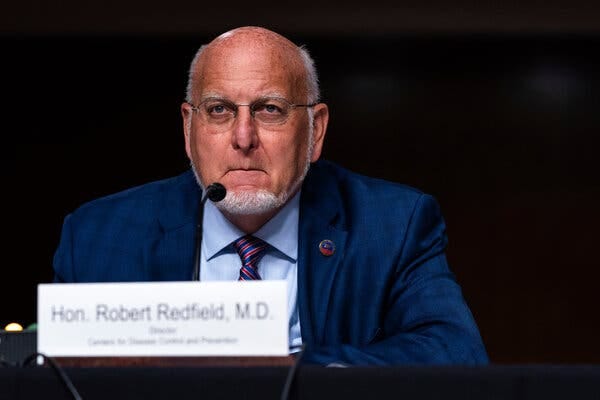
Dr. Robert R. Redfield, director of the Centers for Disease Control and Prevention, testifying on Capitol Hill in September.Credit…Pool photo by Anna Moneymaker
The Centers for Disease Control and Prevention has deleted a disputed document it posted this summer to support President Trump’s hard push to reopen school buildings this fall.
The agency withdrew two school reopening documents last month with no notice or calls for public comment, after acknowledging that some statements it made in July were outdated, according to a congressional subcommittee that launched an investigation into the agency’s summer guidance.
One document in particular, titled “The Importance of Reopening America’s Schools this Fall,” proved particularly contentious because it struck many as reading more like a political speech than a scientific report.
The document contained statements that echoed Mr. Trump’s emphasis on the benefits of returning to in-person learning while downplaying the potential risks the virus carried for children and teachers. It was issued two weeks after Mr. Trump railed against the agency’s school guidance as “very tough and expensive” and threatened to withhold funding from schools that did not offer in-person classes.
“Reopening schools creates opportunity to invest in the education, well-being, and future of one of America’s greatest assets — our children — while taking every precaution to protect students, teachers, staff and all their families,” the document concluded.
A House panel, the Select Subcommittee on the Coronavirus Crisis called on the C.D.C. to rescind the documents and other statements after a New York Times investigation published in September found that they has been heavily influenced by White House officials and issued over the protests of C.D.C. scientists.
“I am pleased that, in response to this request, C.D.C. has now removed two guidance documents unsupported by science,” the committee chairman, Representative James E. Clyburn, Democrat of South Carolina, said in a statement. “With infections rising dramatically across the country, it is critical that schools, teachers and families have accurate, trustworthy public health information on the coronavirus.”
The withdrawal of the July statements was first reported by The Hill. The C.D.C. did not immediately respond to a request for comment.
Last month, the C.D.C.’s deputy incident manager for the Covid-19 response acknowledged in a briefing with committee members that the agency did not “have enough data to be sure” that children are “unlikely to be major drivers of the spread of the virus,” as the July guidance asserted, the committee said.
In an Oct. 23 letter, published by the subcommittee Tuesday, Dr. Robert R. Redfield, the C.D.C. director, told the committee said that “some of the information on our education guidance pages is out of date.”
The most recent C.D.C. guidance, dated Oct. 29, still contains the language “The Importance of Reopening America’s Schools this Fall,” but it now links to “C.D.C. Considerations” for reopenings that are much more measured.
“To be sure, the best available evidence from countries that have reopened schools indicates that Covid-19 poses low risks to school-aged children — at least in areas with low community transmission,” the new guidance says. “That said, the body of evidence is growing that children of all ages are susceptible to SARS-CoV-2 infection and, contrary to early reports might play a role in transmission.”
The F.D.A. authorizes the first at-home coronavirus test.
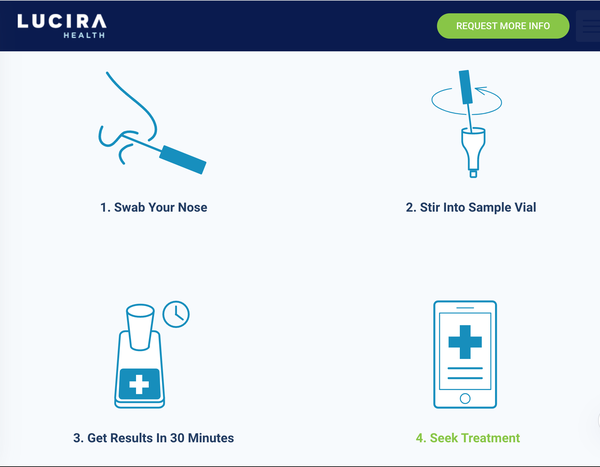
Instructions on how to use the home test from the Lucira Health website.Credit…Lucira Health
The Food and Drug Administration on Tuesday gave an emergency green light to the first rapid coronavirus test that can run from start to finish at home, paving a potential path for more widespread testing outside of health care settings.
The test, developed by the California-based company Lucira Health, requires a prescription from a health care provider. People under the age of 14 also can’t perform the test on themselves. But with a relatively simple nasal swab, the test can return results in about half an hour, and is projected by the company to cost $50 or less, according to the product’s website. Clinicians can also run the test on their patients, including children under the age of 14, potentially delivering answers during a single visit to a care center or pharmacy, instead of routing a tough-to-collect sample through a lab.
A handful of other tests have been cleared by the F.D.A. for at-home collection of samples, which are then shipped to a lab for processing. But Lucira’s test is the first to remove the need for an intermediary.
“Today’s authorization for a complete at-home test is a significant step toward F.D.A.’s nationwide response to Covid-19,” Jeff Shuren, director of the F.D.A.’s Center for Devices and Radiological Health, said in a statement. “Now, more Americans who may have Covid-19 will be able to take immediate action, based on their results, to protect themselves and those around them.”
People who test positive for the coronavirus are expected to isolate themselves from others for 10 days from the day their symptoms started, or the day they tested positive, per guidelines from the Centers for Disease Control and Prevention.
Laboratory tests that look for the coronavirus’s genetic material using a technique called polymerase chain reaction, or P.C.R., are still considered the gold standard for detecting the virus. But the new at-home test relies on similar principles by using a method called a loop mediated amplification reaction, or LAMP. Like P.C.R., LAMP repeatedly copies genetic material until it reaches detectable levels, making it possible to identify the virus even when it is present at only very low levels in the respiratory tract. While faster and less cumbersome than P.C.R., LAMP is generally thought to be less accurate.
People taking the battery-powered test must swirl a swab in both of their nostrils, then dip and stir the swab into a vial of chemicals. That vial is then plugged into a test cartridge that processes the sample. Within half an hour, the test cartridge will light up as “positive” or “negative.” Federal guidelines note that people taking the test should report the results to their health care providers, who must then inform public health authorities to help track the virus’s spread.
According to the product’s instructions, Lucira’s LAMP test was able to accurately detect 94 percent of the infections found by a well-established P.C.R. based test. It also correctly identified 98 percent of the healthy, uninfected people.
The study, which was conducted by the company, was small, and included only people who had symptoms of Covid-19, the disease caused by the coronavirus. The packaging for the test notes that it “has not been evaluated” in asymptomatic people.
AT-HOME TESTING
Read the full article on the F.D.A.’s announcement.
The Mayo Clinic is strained by hundreds of virus infections among its medical staff.
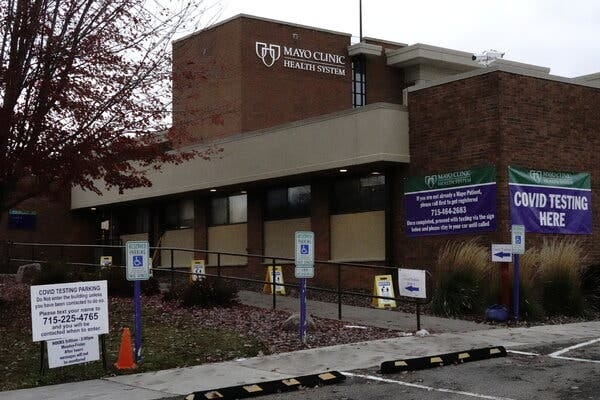
The Mayo Clinic Health System facility in Menomonie, Wis. The Mayo system is dealing with hundreds of coronavirus cases among its staff in Wisconsin and Minnesota.Credit…Bing Guan/Reuters
Hundreds of health care workers at the Mayo Clinic have become infected with the coronavirus, even as the prestigious hospital system is treating rapidly growing numbers of patients with Covid-19.
“All of our hospitals are really stretched,” Dr. Amy Williams, who leads the hospital system’s response to Covid-19, said in a news conference on Tuesday. “Many are absolutely full at this time.”
At its flagship hospital in Rochester, Minn., Covid patients occupied all 32 beds in the medical intensive care unit, she said, and the hospital was adding another dozen beds to cope with the inflow of seriously ill patients expected in the next few weeks.
Staffing has emerged as a critical issue, Dr. Williams said. “We are most concerned about not being able to care for patients because of the decrease in our staff due to Covid-19 reasons, whether it is they are exposed and they’re out on quarantine, they’re taking care of a family member who has Covid-19 or they have been infected themselves,” she said.
In the last two weeks alone, about 900 employees have received a Covid diagnosis in Rochester, in the system’s 20 community hospitals in Wisconsin and Minnesota, or in the outpatient clinics it operates there. Both states are experiencing sustained surges in cases that are far worse than at any previous time in the pandemic, with Minnesota reporting nearly 6,000 new cases on Tuesday.
Most of the infections among the Mayo Clinic staff have occurred from community spread, Dr. Williams said, while a few have been traced to exposure from other employees when eating together unmasked. “We’re really not seeing exposures from patient to staff,” she said.
With about 1,500 of its 55,000 employees in the Midwest now sidelined because of the virus, the organization is asking recently retired nurses to come back to work; relocating nurses from its facilities in Arizona; and shifting nurses from other aspects of its operations, like research, to help care for patients. The Mayo hospital system have also cut back on the number of nonessential procedures it is performing.
ADVERTISEMENT
Continue reading the main story
With no national strategy in the U.S., a patchwork of local responses gathers speed.
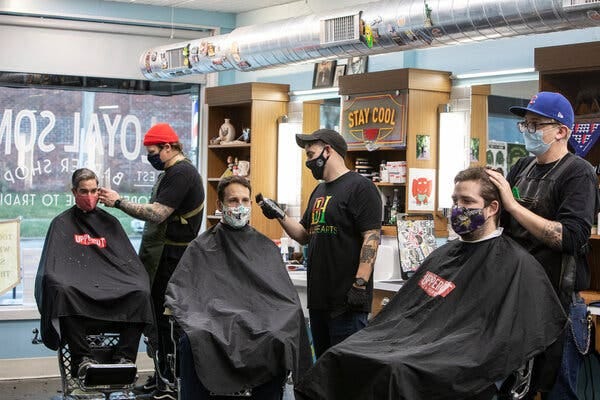
Customers at a barber shop in Des Moines on Tuesday. Iowa is set to introduce a statewide mask order.Credit…Kathryn Gamble for The New York Times
One day after the governor of California announced that the state was “pulling the emergency brake” on its reopening and reinstating broad restrictions, Los Angeles County went a step further on Tuesday and announced a curfew for businesses.
Starting Friday, restaurants, breweries, bars, wineries and nonessential retail establishments must close from 10 p.m. to 6 a.m. A similar move is being considered statewide.
“This is a different kind of moment, a new level of danger,” Mayor Eric Garcetti said on Monday before the new measures were announced. “If we don’t make these decisions now, there really is only one outcome: We will almost certainly have to shut things down again. And more people will get sick and die.”
The moves in California came as state and local leaders across the United States try to slow the coronavirus, which has killed nearly 250,000 Americans and is now setting daily records for the number of people hospitalized with the disease. On Wednesday morning, that number stood at 76,823, according to the Covid Tracking Project.
Dr. Anthony S. Fauci, the government’s top infectious disease expert, said on Tuesday that the nation needed “a uniform approach,” instead of a “disjointed” state-by-state, city-by-city response.
But that is not what is happening. Like in the spring, when the country failed to develop a coordinated national response, a patchwork of measures is being put in place to combat the virus. Public health experts say the lack of a national strategy has been a primary reason for the country’s world-leading caseload and death toll.
Unlike in the spring, the virus is now spreading much more widely, exacting a deadly toll in communities from coast to coast. On Tuesday, more than 1,580 new deaths were reported nationwide, the highest single-day total since mid-May. Five states set single-day records for new deaths.
In the past two days, Ohio announced a nightly curfew, and Mississippi extended a mask mandate to seven more counties. Iowa will issue its first statewide mask order, Maryland will order all bars, restaurants and night clubs to close by 10 p.m., and Pennsylvania will require anyone who enters the state to be tested before arrival.
In Illinois, Gov. J.B. Pritzker said that, starting Friday, the entire state would move to Tier 3 under its mitigation plan, which limits the number of customers at many businesses and restricts private indoor gatherings to people in the same household, among other measures. Casinos and indoor venues like theaters and museums must close, and outdoor group activities will be limited to 10 people.
In Maryland, Gov. Larry Hogan announced that, beginning Friday, all bars, restaurants and night clubs would have to close by 10 p.m. and businesses, religious institutions and organizations would be limited to 50 percent of capacity.
In Mississippi, where Gov. Tate Reeves lifted a statewide mask mandate in September, new extensions in parts of the state meant that masks were only required in 22 counties out of 82.
Gov. Mike DeWine of Ohio, a rare Republican leader of a red state who has consistently bucked President Trump’s opposition to tough restrictions, announced that his state would be under a curfew from 10 p.m. until 5 a.m. for three weeks starting on Thursday.
Ohio has reported a daily average of more than 7,000 new cases over the past week, seven times as many as in early October and more than at any time since the pandemic began. “These are astronomical numbers,” the governor said at a news conference on Tuesday, urging residents to wear masks and maintain strict social distancing until a vaccine is widely available.
Mr. DeWine said all retail businesses would have to close during the curfew and that residents should stay home unless they are commuting to work or traveling for emergency purposes. He called the rules “common sense.”
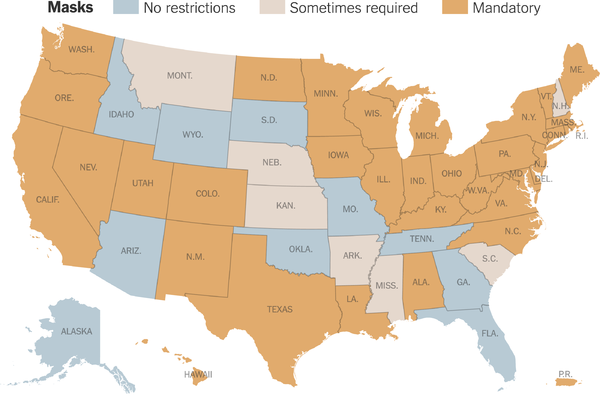
See Coronavirus Restrictions and Mask Mandates for All 50 States
— Marc Santora and Ron DePasquale
An out-of-control pandemic is speeding the hunt for vaccines.

A volunteer in Detroit participates in a trial of Moderna’s vaccine. On Monday, the company announced that an early analysis had found its vaccine to be 94.5 percent effective. Credit…Henry Ford Health, via Agence France-Presse — Getty Images
In the past week, the United States has reported a daily average of nearly 160,000 new coronavirus cases. The virus is overwhelming health systems and killing more than 1,100 Americans a day. But there is a slender silver lining: It is hastening the testing of vaccines that could eventually end the pandemic.
The surging virus has already allowed the drugmakers Pfizer and Moderna to accelerate the testing of their vaccines, which appear to be very effective at preventing Covid-19.
In late-stage vaccine trials, the faster that participants get sick, the faster that drug developers gain enough data to know whether their vaccines are effective.
Pfizer said on Wednesday that its coronavirus vaccine was 95 percent effective and had no serious side effects — the first set of complete results from a late-stage vaccine trial as Covid-19 cases skyrocket around the globe.
Moderna announced on Monday that an early analysis had found its vaccine to be 94.5 percent effective. The company had planned on needing only 53 cases of Covid-19 to turn up in its trial before experts would take a first look at the data. But the nationwide surge in infections helped Moderna blow past that number: The results were based on 95 sick participants.
The fast-growing pandemic could also speed up trials of treatments for Covid-19.
The drug company Regeneron, for example, is testing the antibody treatment that President Trump received after he caught Covid-19. A company spokeswoman said enrollment in its trial has accelerated slightly this month.
Even if the grim situation in the United States ultimately helps vaccines and treatments become available sooner, the country would have been much better off if it had kept the pandemic under control, public health experts said.
“This is not how anyone would want it to play out,” said Natalie Dean, a biostatistician and an expert in vaccine trial design at the University of Florida. “I’d rather be South Korea,” which has kept the virus at bay since early in the year, she said.
— Rebecca Robbins
HUNT FOR VACCINES
Read more about Pfizer’s latest results and how researchers are able to measure the effectiveness of their drugs more quickly.
In new results, Pfizer says its vaccine is safe and 95% effective.

Days after reporting a 90 percent effectiveness rate for its coronavirus vaccine, Pfizer is reporting new results showing 95 percent effectiveness.Credit…Pfizer, via Reuters
The drugmaker Pfizer said on Wednesday that its coronavirus vaccine was 95 percent effective and had no serious side effects — the first set of complete results from a late-stage vaccine trial as Covid-19 cases skyrocket around the globe.
The data showed that the vaccine prevented mild and severe forms of Covid-19, the company said. And it was 94 percent effective in older adults, who are more vulnerable to developing severe Covid-19 and who do not respond strongly to some types of vaccines.
Pfizer, which developed the vaccine with its partner BioNTech, said the companies plan to apply to the Food and Drug Administration for emergency authorization “within days,” raising hopes that a working vaccine could soon become a reality.
The trial results — less than a year after researchers began working on the vaccine — shattered all speed records for vaccine development, a process that usually takes years.
If the F.D.A. authorizes the two-dose vaccine, Pfizer has said that it could have up to 50 million doses available by the end of the year, and up to 1.3 billion by the end of next year.
However, only about half of its supply will go to the United States this year, or enough for about 12.5 million people — a sliver of the American population of 330 million. Americans will receive the vaccine free of charge, under a $1.95 billion deal the federal government reached with Pfizer for 100 million doses.
Federal health officials have said the first doses of the vaccines will likely go to groups like health care workers who are at high risk for exposure, as well as people who are most vulnerable to the disease, such as older people.
The results align with an early analysis that Pfizer and BioNTech reported last week, which found that the vaccine was more than 90 percent effective. Then on Monday, the drugmaker Moderna reported that its vaccine was 94.5 percent effective in an early analysis.
Dr. Saad Omer, the director of the Yale Institute for Global Health, said the results showing the vaccines protected people from severe disease was good news, because with such limited availability initially, the first goal will be not to stop transmission of the disease, but to prevent people from becoming extremely ill. “So that is very reassuring,” he said.
If the vaccine is authorized, attention will immediately shift to how it will be distributed. The vaccine must be stored at minus 94 degrees Fahrenheit, colder than any other vaccine in development. Pfizer will ship the vaccine in special boxes of 1,000 to 5,000 doses that are stuffed with dry ice and equipped with GPS-enabled sensors.
VACCINE RESULTS
Read more about Pfizer’s vaccine, which the company says is highly effective.
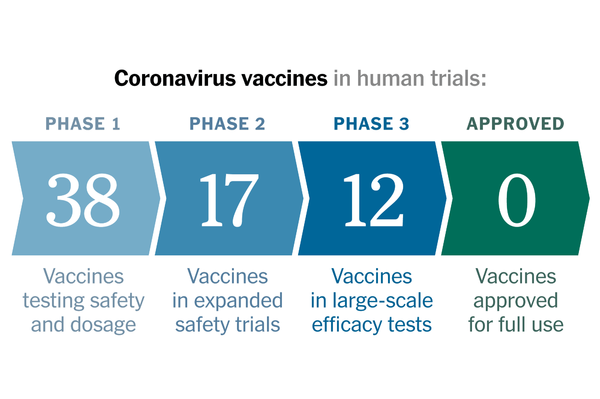
Coronavirus Vaccine Tracker
A look at all the vaccines that have reached trials in humans.
ADVERTISEMENT
Continue reading the main story
GLOBAL ROUNDUP
France surpasses two million cases, and other news from around the world.
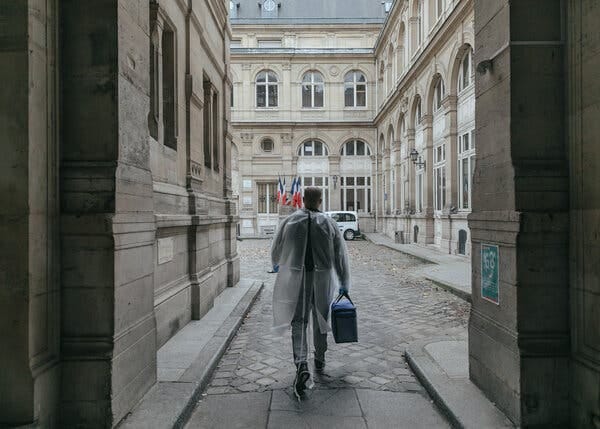
A medical worker in Paris last month. France is seeing its peak level of coronavirus hospitalizations.Credit…Andrea Mantovani for The New York Times
Even as France became the first country in Europe to pass two million detected cases of coronavirus infection this week, authorities expressed optimism that weeks of restrictions on movement and social interactions were starting to slow the spread of the virus.
“Our collective efforts are starting to bear fruit,” Jérôme Salomon, a top health ministry official, said at a news conference on Tuesday.
Still, French officials warned that lockdown restrictions would have to remain in place for at least several more weeks. France recorded more than 45,000 new cases over the previous 24 hours, bringing the country’s total to 2,036,755.
The number of hospitalized Covid-19 patients peaked at nearly 33,500 this week — slightly more than during the first wave last spring — and the pressure on French hospitals is still “very strong,” Mr. Salomon said.
Over 46,000 deaths have been tied to the virus in France.
France last month became one of the first countries in Europe to return to a nationwide lockdown, albeit one markedly less draconian than the measures put in place in the spring.
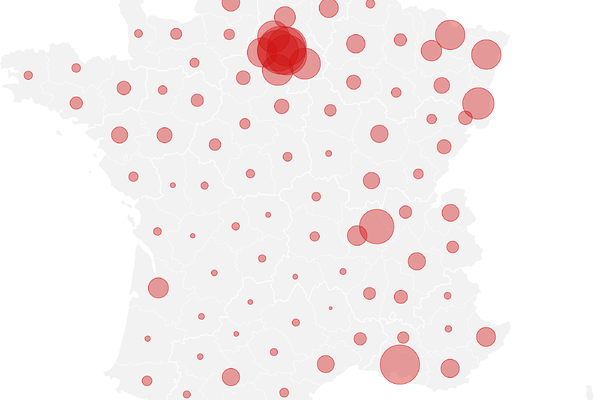
France Covid Map and Case Count
Public gatherings are banned, restaurants, bars and cinemas are once again closed and movement outside the home has been limited. But parks and schools are still open and a wider range of businesses are allowed to remain open.
The limits could start to be lifted next month.
The French authorities are considering allowing small businesses and shops to reopen in the run-up to Christmas. Catholic worshipers have also protested in recent days, demanding that the government relax a ban on religious services.
But officials said they would only loosen the rules if the trends remain encouraging. A government spokesman, Gabriel Attal, said at a news conference on Wednesday that while there might be an “adaptation” of the rules next month, the country was “far from” lifting the lockdown.
At the same time, officials sought to reassure the public, saying that while the road may be long and hard, the country was on the right path.
“Your efforts are starting to pay off, you must definitely not stop them,” Olivier Véran, the health minister, told the BFM TV news channel on Tuesday. “Yes it’s long, yes it’s difficult, but that’s the price to return to a normal life.”
In other news from around the world:
- The “Sweden model” of very light restrictions has been the subject of fascination even as the effectiveness of the approach is still debated. But on Tuesday, King Carl XVI Gustaf captured a country dramatically shifting to deal with a sharp virus surge: “Hold on tight,” he said in a statement posted on Instagram. The government announced the strictest limitations on the country since the coronavirus first appeared and warned that there will be darker days ahead. While Sweden’s number of Covid-19 deaths still pales in comparison to those countries like Italy or Spain, it is more than 10 times higher than in Finland or Norway.
- The Turkish government, facing growing public anger over its handling of the pandemic and accusations that it is hiding the true toll of the coronavirus as the number of deaths rise, announced that it would close classrooms and impose new restrictions on movement on the weekends as part of a raft of measures to slow the spread. Restaurants and cafes will only be allowed to serve takeout, and shopping malls will be forced to close at 8 p.m. Turkey has reported at least 11,700 deaths, with more than 420,000 cases of infection. Local officials and opposition politicians say the government is hiding the true death toll.
- The state of South Australia will go into lockdown for six days to contain a growing outbreak. The cluster, which has been traced to a traveler quarantining in a hotel, has included 22 cases since Saturday. Starting at midnight on Wednesday, only one person per household will be able to go out each day to access essential services like groceries or medical services. Restaurants, cafes, pubs and retail stores will close, as will schools and universities. Outdoor sports and physical activities are banned, and masks will be mandatory. After the six-day lockdown, South Australia will face another eight days with fewer restrictions, details of which have not yet been announced.
Biden calls on the G.S.A. head to authorize the transition so he can focus on the pandemic response.
Video
TRANSCRIPT
0:00/1:30
Biden Pressures Trump for Access to Federal Resources
President-elect Joseph R. Biden Jr. spoke with a group of health care workers on Wednesday, pressuring the Trump administration to authorize giving him access to federal resources to plan his coronavirus response.
One of the problems that we’re having now is the failure of the administration to recognize — the law says that the General Services Administration has a person who recognizes who the winner is. And then they have to have access to all the data and information that the government possesses to be prepared. And it doesn’t require there to be an absolute winner and says the apparent winner the apparent winner. And we’ve been unable to get access to the kinds of things we need to know about the depth of the stockpiles we know there’s not much at all. And there’s a whole lot of things that are just we just don’t have available to us unless it’s made available soon, we’re going to be behind by weeks or months being able to put together the whole initiative relating to the biggest promise we have with two drug companies coming along and finding 95% effectiveness, efficiency in the vaccines, which we put together. I think a first rate team that you would all be proud of and we’re all ready to go. And doing an awful lot of work right now. And I’m hoping that the reason why my friends on the other side have not stepped up to do something is because of their fear of retribution from the president. And hopefully when he’s gone they’ll be more willing to do what they know should be done has to be done in order to save the communities.
00:00
1:29
1:29Biden Pressures Trump for Access to Federal Resources
President-elect Joseph R. Biden Jr. spoke with a group of health care workers on Wednesday, pressuring the Trump administration to authorize giving him access to federal resources to plan his coronavirus response.CreditCredit…Ruth Fremson/The New York Times
President-elect Joseph R. Biden Jr. put new pressure Wednesday on the Trump administration to authorize a presidential transition, telling a group of workers that the head of the General Services Administration could act now to give him access to federal resources to help plan his coronavirus response.
“The law says that the General Services Administration has a person who recognizes who the winner is,” Mr. Biden said. “And then they have to have access to all the data and information that the government possesses.”
“And it doesn’t require that there be an absolute winner. It says the ‘apparent’ winner. The ‘apparent’ winner,” Mr. Biden said.
Mr. Biden asked the small group gathered on a video call, which included nurses and a firefighter, to describe their experiences dealing with the virus, and he pledged to mount a major new effort to combat the pandemic. “We’re all ready to go and do an awful lot of work right now,” Mr. Biden said.
But he said his ability to plan was restricted by the delayed transition caused by President Trump’s refusal to acknowledge his victory and the refusal of Emily W. Murphy, the G.S.A. administrator, to sign the paperwork that would grant Mr. Biden’s transition team access to funds, equipment and government data.
Mr. Biden said he did not “have any budget for any of this” until he was sworn in or until Mr. Trump conceded defeat and began a transition. But he noted that he planned to work with state and local leaders on mask mandates.
Mr. Biden also complained that Senate Republicans had not agreed to the stimulus spending passed by the House earlier this year. (Senate Republicans offered their own scaled-back stimulus plan that failed to reach the 60-vote threshold necessary to advance the bill.)
“I’m hoping that the reason why my friends on the other side have not stepped up to do something is because of their fear of retribution from the president,” Mr. Biden said. “And hopefully when he’s gone, they’ll be more willing to do what they know should be done — has to be done — in order to save the communities they live in.”
“This is like going to war,” Mr. Biden added about fighting the pandemic. “You need a commander in chief.”
Mr. Biden also noted that, while deprived of access to federal experts and data, he had been immersing himself in the details of the pandemic since the spring, saying that he had been getting regular briefings for months “from some of the leading docs in the country.”
The Biden transition did not provide names and precise job descriptions of the people with whom Mr. Biden spoke.
A looming hospital crisis forced Iowa’s Republican governor to change course on masks.
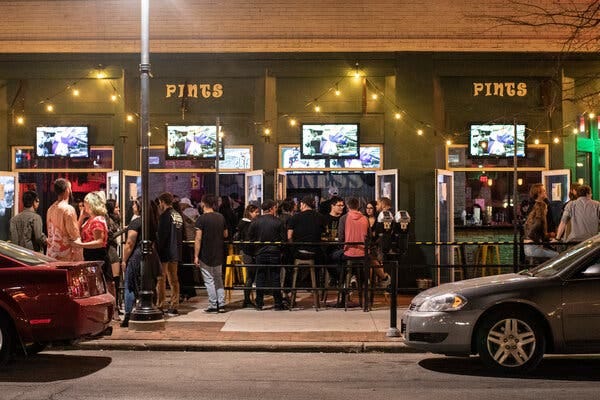
Patrons at a bar in Des Moines earlier this month. Iowa’s governor imposed a mask mandate this week to halt sharp increases in new virus cases and hospitalizations.Credit…Kathryn Gamble for The New York Times
For months, Gov. Kim Reynolds of Iowa saw little need to intervene in the choices of Iowans, who she insisted could make their own decisions about whether to wear a mask to protect against a dangerous pandemic.
But as the virus ravaged her state and hospitals filled to the brink, Ms. Reynolds abruptly reversed herself this week and began requiring that masks be worn indoors when the wearer will be close to another person for more than 15 minutes.
She joined a wave of Republican governors who are newly, and at times reluctantly, wielding the power of their offices to require coronavirus precautions as the erupts to crisis levels across the United States.
“No one wants to do this,” Ms. Reynolds said in a live address to Iowa, which now has the third-highest rate of new cases in the nation relative to its population. “I don’t want to do this.”
Interviews with more than a dozen political, health and business leaders in Iowa — including some the governor consulted before issuing the order — show that her hand was forced by a spiraling hospital crisis. As pressure built from doctors, mayors and even people in her own administration, the message was clear: If she did not act, Iowa’s hospitals could soon be overflowing with coronavirus patients.
More than 4,100 people are newly testing positive for the virus in Iowa each day on average, an 86 percent increase from two weeks ago. Hospitalizations have doubled in the same period, and coronavirus patients now account for one out of four people admitted to hospitals in the state.
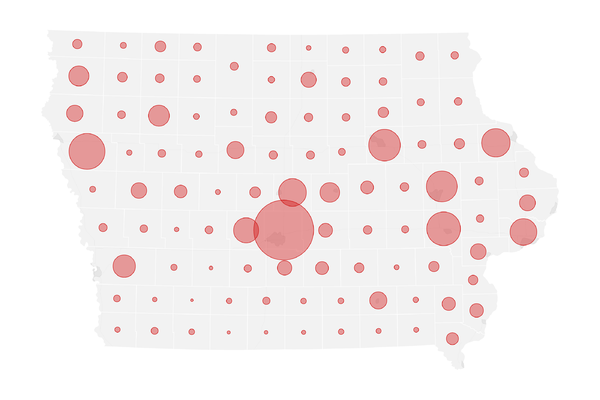
Iowa Covid Map and Case Count
“What has really changed in the last couple of weeks is the hospitalization rate,” said Suresh Gunasekaran, chief executive of the University of Iowa Hospitals and Clinics, describing his regular discussions with the governor, her aides and health officials in the state. “I think that was what really persuaded the whole state, including the governor.”
— Sarah Mervosh, Nicholas Bogel-Burroughs, Giulia McDonnell Nieto del Rio and Tim Arango
CRISIS IN IOWA
ADVERTISEMENT
Continue reading the main story
A lawsuit accuses New York City of blocking the release of coronavirus records.

The lawsuit is seeking documents that may disclose whether the city botched its response to the coronavirus pandemic, which has killed more than 24,000 New Yorkers and devastated the city’s economy.Credit…Erin Schaff/The New York Times
The New York City comptroller’s office filed a lawsuit on Wednesday seeking to force Mayor Bill de Blasio’s administration to turn over documents that may disclose whether the city botched its response to a coronavirus pandemic that has killed more than 24,000 New Yorkers and devastated the city’s economy.
The office of the comptroller, Scott M. Stringer, issued a subpoena in June as part of its investigation, which Mr. Stringer said was an effort to understand how the city made the decision to initially keep public schools open, and why frontline workers did not have access to protective equipment.
But the city has yet to turn over records from key agencies such as the health department or the city’s public hospitals, the lawsuit said.
“The city’s refusal to timely and fully comply with the subpoena is impeding and frustrating the comptroller’s ability to complete the investigation, as well as the exercise of the comptroller’s investigative authority,” Mr. Stringer’s office wrote in the lawsuit, which was filed in State Supreme Court in Manhattan.
Mr. Stringer said at a news conference in front of City Hall on Wednesday that the city appears to be intentionally stonewalling the query, which asks for records from November 2019 through March 22, 2020.
“I really don’t know what they are hiding,” Mr. Stringer said. “But I’ve had enough.”
The comptroller’s office has received about 30,000 pages of documents from the Fire Department and the Office of Emergency Management, officials said. But the city said that other agency documents will not be available until April 2021, almost a year after the investigation began.
City Hall officials questioned Mr. Stringer’s motivations, noting that he is considered to be one of the leading candidates to replace Mr. de Blasio as mayor in next year’s election.
“Sounds like a politician running for mayor, not someone focused on the public health crisis at hand,” said Bill Neidhardt, the mayor’s press secretary.
Senator Steve Daines, taking part in a vaccine trial, tests positive for antibodies.
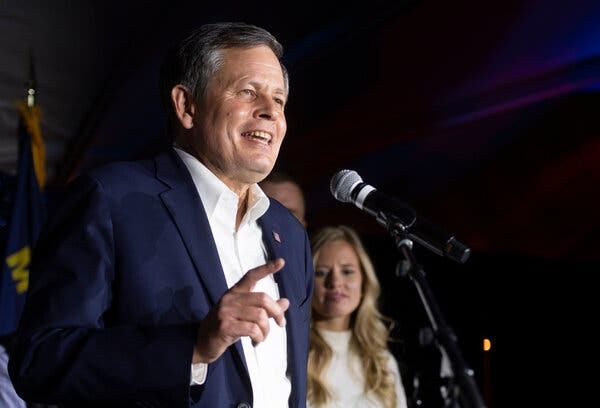
Senator Steve Daines, Republican of Montana, participated in a Pfizer coronavirus vaccine trial and has since tested positive for coronavirus antibodies.Credit…Tommy Martino/Associated Press
Senator Steve Daines, Republican of Montana, announced on Wednesday that he had participated in the Pfizer vaccine trial and has since tested positive for coronavirus antibodies. Mr. Daines is one of two Republican senators participating in a vaccine trial, and is among a handful of lawmakers who have since tested positive for antibodies since the pandemic began to spread in the United States.
Like Senator Rob Portman, Republican of Ohio, a participant in a trial of a vaccine being developed by Johnson & Johnson, Mr. Daines said he took part out of a desire to stem the spread of misinformation about the safety of a vaccine and underscore its benefits. Pfizer announced a 95 percent effectiveness rate for its vaccine on Wednesday, and plans to seek emergency authorization from the Food and Drug Administration in the coming days.
“My goal is to help build confidence and trust for Montanans and the American people wondering if they should take the vaccine when it is approved,” Mr. Daines said in a statement. “This is about saving lives. This is about supporting our health care heroes.”
Mr. Daines made a point of noting that he did not believe in mandating a vaccine, but “would, however, encourage people to get the vaccine once approved, in consultation with their doctor. ”
The announcement from Mr. Daines came as Capitol Hill was experiencing a mini-outbreak, with two of the oldest sitting lawmakers testing positive for the coronavirus and a handful of other representatives in isolation because of possible exposure to the virus. After having tested positive for the coronavirus on Tuesday, Senator Charles E. Grassley of Iowa, the chairman of the Senate Finance Committee and the oldest Senate Republican at 87, said on Twitter Wednesday, “I remain symptom free & in isolation.” Also on Wednesday, Representative Doug Lamborn, Republican of Colorado, announced that he had recently tested positive for the virus and would be isolating at his home in Colorado Springs.
A protest in Berlin against virus restrictions turns violent.
Video
00:00
0:46
0:46Police Break Up Protest Against Virus Restrictions in Germany
Riot police in Berlin used water canons to disperse crowds at a demonstration against coronavirus restrictions organized by coronavirus deniers, vaccine skeptics and right-wing extremists on Wednesday.CreditCredit…Filip Singer/EPA, via Shutterstock
BERLIN — Police broke up an organized protest by coronavirus deniers, vaccine skeptics and right-wing extremists in Berlin on Wednesday as lawmakers passed legislation meant to undergird the government’s efforts to contain the spread of the virus.
Police officers in riot gear used water cannons to disperse the crowd, which gathered near the Brandenburg Gate. The protesters were ordered to leave around noon because they refused to wear masks or keep social distance. Some protesters threw rocks, bottles and firecrackers at the police in response.
As many as 10,000 demonstrators descended on the city in an effort to stop lawmakers from passing a bill that they said would give the state and federal governments too much power to override basic constitutional rights in the fight against the pandemic.
While Chancellor Angela Merkel’s pandemic response has found broad acceptance, opponents have been demonstrating actively since the government instituted its first lockdown in the spring. The protest movement combines people who question the government’s response to the pandemic, those who deny the existence of the virus altogether and those who have long called for the overthrow of Ms. Merkel’s government.
Not far from the water cannons, inside the Reichstag, where lawmakers debated the bill, far-right lawmakers from the nationalist AfD party protested the proceedings by refusing to wear masks and by ignoring social distancing rules. Other AfD lawmakers could be seen mingling with the demonstrators outside.
Federal and city authorities decided on Tuesday that a protest in front of the Reichstag building would be prohibited because it could disrupt proceedings in Parliament. During a big protest in August, a small group of protesters managed to climb the stairs of the Reichstag, prompting a nationwide outcry.
ADVERTISEMENT
Continue reading the main story
Some New York officials won’t enforce the state’s 10-person gathering limit.

Steve McLaughlin, a Republican who is the Rensselaer County executive and a frequent critic of the governor, called the rules unenforceable. Credit…Hans Pennink/Associated Press
Hours before New York State’s order limiting private gatherings took effect on Friday, effectively barring large holiday parties, an upstate sheriff said that he would not enforce it. His office, he said, would never interfere with “the great tradition of Thanksgiving dinner.”
Under an executive order, indoor and outdoor gatherings at private homes were limited to 10 people aside from residents. Gov. Andrew M. Cuomo said the rule was intended to target house parties, which the state’s contact tracers have found to be a significant source of new infections.
The state’s daily numbers of new coronavirus cases is climbing, threatening New York’s progress toward tamping down the spread of infection.
New York is not the only state to impose such a restriction leading up to Thanksgiving. New Jersey and Connecticut have issued similar rules; Michigan has banned indoor gatherings of more than two households; and Vermont and Washington State barred indoor gatherings outside of immediate households.
New York’s rule is in line with guidance from the Centers for Disease Control and Prevention, which says the safest way to have a Thanksgiving gathering is to keep it limited to one’s household.
Conservative local officials and sheriffs have so far issued the fiercest rebukes of Mr. Cuomo’s order, which was announced last week. Their open refusals to enforce the ban reflect a national pattern of conservative officials’ criticizing restrictions meant to keep the virus at bay, orders that opponents denounce as violations of civil liberties.
“It is unenforceable,” said Steve McLaughlin, a Republican who is the Rensselaer County executive and a frequent critic of Mr. Cuomo. The county’s sheriff has said he would not enforce the order. “And I believe it’s unconstitutional as does pretty much every sheriff I’ve spoken to.”
At a news conference on Wednesday, Mr. Cuomo blasted the sheriffs who said they were not planning to enforce his eecutive order.
“I don’t believe as a law enforcement officer, you have a right to pick and choose whta laws you will enforce,” he said.
He added: “It’s arrogant, and it violates your constitutional duty.”
THANKSGIVING BACKLASH
As coronavirus numbers continue to increase, Gov. Andrew M. Cuomo has halted large holiday gatherings, but his order has been met with opposition.
Boston’s mayor tells college students: If you go home for Thanksgiving, stay home until the spring.
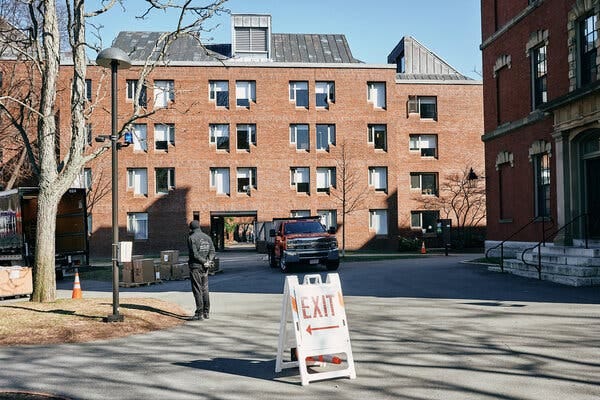
Harvard’s campus earlier this year. Boston’s mayor is urging the city’s 140,000 college students to stay at home for the rest of the school year if they travel for the Thanksgiving holiday.Credit…Tristan Spinski for The New York Times
The mayor of Boston — where roughly 140,000 students attend some 30 colleges and universities — said that if students planned to go home for the Thanksgiving holiday, they should not plan on returning anytime soon.
“If you go home for Thanksgiving, you should not be returning to Boston this semester,” Marty Walsh, the city’s mayor, wrote on Twitter on Tuesday.
His announcement added another wrinkle to what was already an agonizing and complicated choice facing students across the United States: go home and spend time with their family, possibly putting them at greater risk of contracting the coronavirus, or stay on campus and celebrate the holiday in a new way.
Schools like Boston University have been pleading with students to stick around for a “Friendsgiving” on campus. If students do leave, even if they do not travel outside the state, university officials said they would have to self-isolate for seven days when they return, and test negative three times befoe returning to class, according to BU Today.
“This means remaining in your room, attending courses remotely, and exiting the building only for medical appointments or meals,” Kenneth Elmore, the dean of students, wrote in an email to students, according to the university newspaper. “Violations of this advisory may result in disciplinary action up to and including suspension”
Eager to avoid the logistical nightmare of thousands of students migrating in and out because of the holiday, many universities around the country — including the University of Connecticut and New York’s SUNY campuses — have planned to end in-person classes before Thanksgiving and require students to finish the term remotely.
For colleges and universities that are encouraging students to return home until the spring semester, the measures they are taking to reduce the chances that those students might carry the coronavirus with them are a patchwork. Many are offering little more than optional testing and advice. Only a minority of schools are mandating that students test negative for the coronavirus before they leave campus.
THANKSGIVING BREAK
Read more about concerns that college students will take the coronavirus home for the holiday.
A new study questions whether masks protect wearers. You need to wear them anyway.

Danish participants in the study reported their own test results; mask use was not independently verified, and users may not have worn them correctly.Credit…Claus Bjoern Larsen/Ritzau Scanpix, via Associated Press
Researchers in Denmark reported on Wednesday that surgical masks did not protect the wearers against infection with the coronavirus in a large randomized clinical trial. But the findings conflict with those from a number of other studies, experts said, and are not likely to alter public health recommendations in the United States.
The study, published in the Annals of Internal Medicine, did not contradict growing evidence that masks can prevent transmission of the virus from wearer to others. But the conclusion is at odds with the view that masks also protect the wearers — a position endorsed just last week by the Centers for Disease Control and Prevention.
Critics were quick to note the study’s limitations, among them that the design depended heavily on participants reporting their own test results and behavior, at a time when both mask-wearing and infection were rare in Denmark.
Coronavirus infections are soaring throughout the United States, and even officials who had resisted mask mandates are reversing course. Roughly 40 states have implemented mask requirements of some sort, according to a database maintained by The New York Times.
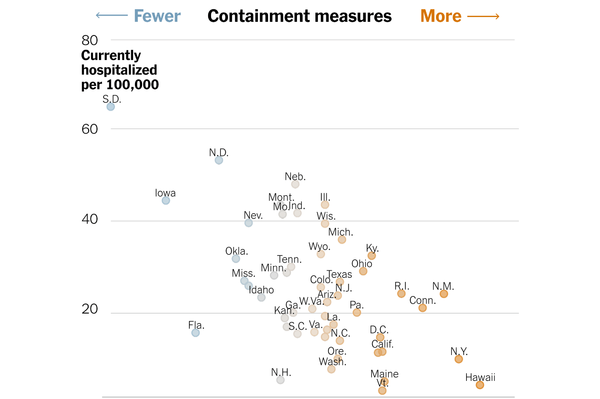
States That Imposed Few Restrictions Now Have the Worst Outbreaks
From early April to early June, researchers at the University of Copenhagen gave half their recruits surgical masks and said to wear them when leaving their homes; the others were told not to wear masks in public.
At that time, 2 percent of the Danish population was infected — a rate lower than that in many places in the United States and Europe today. Social distancing and frequent hand-washing were common, but masks were not.
The researchers had hoped that masks would cut the infection rate by half among wearers. Instead, 42 people in the mask group, or 1.8 percent, got infected, compared with 53 in the unmasked group, or 2.1 percent. The difference was not statistically significant.
“Our study gives an indication of how much you gain from wearing a mask,” said Dr. Henning Bundgaard, lead author of the study and a cardiologist at the University of Copenhagen. “Not a lot.”
Participants reported their own test results; mask use was not independently verified, and users may not have worn them correctly. Also, the incidence of infections in Denmark was lower than it is today in many places, meaning the effectiveness of masks for wearers may have been harder to detect, some experts noted.
The study’s conclusion flies in the face of other research suggesting that masks do protect the wearer. In its recent bulletin, the C.D.C. cited a dozen studies finding that even cloth masks may help shield those who wear them.
Susan Ellenberg, a biostatistician at the University of Pennsylvania Perelman School of Medicine, noted that protection conferred by masks on the wearer trended “in the direction of benefit” in the trial, even if the results were not statistically significant.
“Nothing in this study suggests to me that it is useless to wear a mask,” she said.
DANISH MASK STUDY
ADVERTISEMENT
Continue reading the main story
Jordan, once a model of virus control, is now, is now a hot spot.
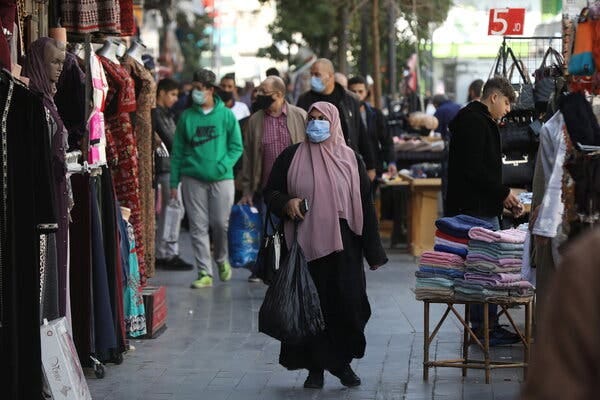
A market in Amman before a five-day lockdown earlier this month.Credit…Muhammad Hamed/Reuters
Jordan, which was commended worldwide for its early efforts to counter the pandemic, has now become one of the hardest-hit countries in the region, along with Lebanon and Iran.
The country has averaged more than 5,000 coronavirus cases a day in the past two weeks, according to a New York Times database. On Wednesday, Jordan recorded 7,933 cases, its highest number since March, according to the health minister.
The government attributed the recent sharp increase to the infection of 1,893 people at two factories in the southern city of Aqaba.
“It’s not just the U.S. and Europe facing devastating second waves,” said Nazanin Ash, the International Rescue Committee’s vice president of policy and practice. “Crisis-affected countries, which are already dealing with unfathomable levels of hunger, economic distress, crippled health systems and infrastructure, are now facing second waves that could be even more devastating than the first.”
In addition to Jordan’s domestic problems with poverty and health care, it must also assist the Syrian refugees who make up more than 10 percent of the country’s population, according to the World Food Program.
In March, the government imposed some of the tightest restrictions in the world as the virus spread in surrounding countries. The lockdown forbid people to leave their homes, suspended schools, banned public gatherings and closed borders and airports. In May, Jordan relaxed most public health restrictions.
Over all, Jordan has had 163,926 cases and 1,969 deaths, Johns Hopkins reported.
On Nov. 11, the country held parliamentary elections with the lowest turnout in a decade, followed by a lockdown and a curfew kept in effect for four days.
The lockdown did not stop some candidates and their supporters from venturing out and celebrating with gunfire. Crowds were seen, many of them not wearing masks, in videos that spread on social media.
The brief lawlessness prompted an apology from the prime minister, and the minister of interior was forced to resign. Citing the crowds and celebrations, the government predicted a new spike in cases.
— Rana F. Sweis
Something Elizabeth Warren and Jamie Dimon agree on: The presidential transition must begin.
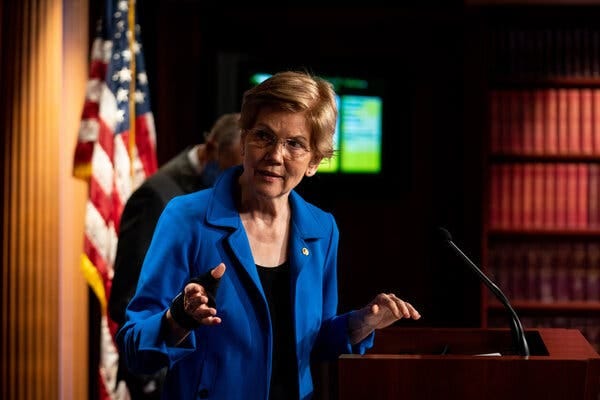
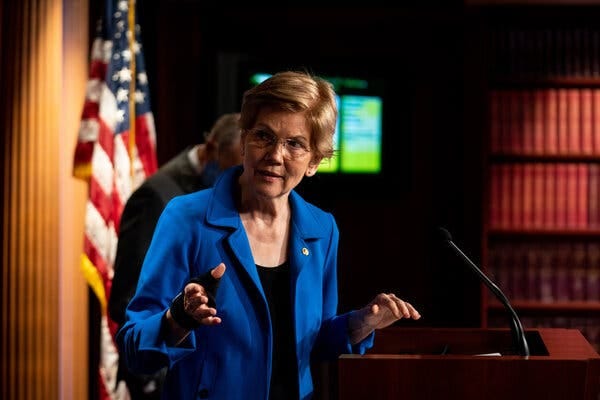
Senator Elizabeth Warren of Massachusetts in September. She said on Tuesday that she was “very worried about the transition process.” Credit…Anna Moneymaker for The New York Times
The consequences of President Trump’s refusal to concede the election has leaders in government and business worried. Speaking at the DealBook Online Summit Tuesday and Wednesday, they said administrative delays threaten a smooth transition that’s especially critical in a pandemic and amid economic crisis. Massachusetts Senator Elizabeth Warren said she was “very worried about the transition process.”
“This is not a game,” Ms. Warren added. “People around the world, people who would do us harm, are watching what’s happening. They’re watching the delay in the transition.”
Jamie Dimon, the chief executive of JPMorgan Chase, expressed similar dismay: “We need a peaceful transition. We had an election. We have a new president. We should support that, whether you like the election outcome or not, you should support the democracy because it is based on a system of faith and trust. ”
Refusal to concede doesn’t present just abstract threats, experts said. There are practical considerations, like the fact that the General Services Administration has so far refused to acknowledge President-elect Joseph R. Biden Jr.’s win, which means the incoming administration has no access to offices, experts, funds and information it needs to manage the pandemic and to govern in January.
The nation’s top infectious disease expert, Dr. Anthony S. Fauci, noted during the summit that in 35 years he has dealt with six administrations through five transitions. “I can say that transitions are extremely important to the smooth continuity of what we are doing,” he said. “You want to have the continuity.”
Albert Bourla, the chief executive of Pfizer, similarly noted on Tuesday that working on a coronavirus vaccine approval and release during a transition is not “ideal,” adding, “It’s always better when there is clear accountability and leadership.” Pfizer on Wednesday said that it planned to seek emergency regulatory approval for its vaccine “within days”; preliminary data have shown the vaccine to be 95 percent effective.
Kentucky closes its schools and bans indoor dining again as virus cases surge.
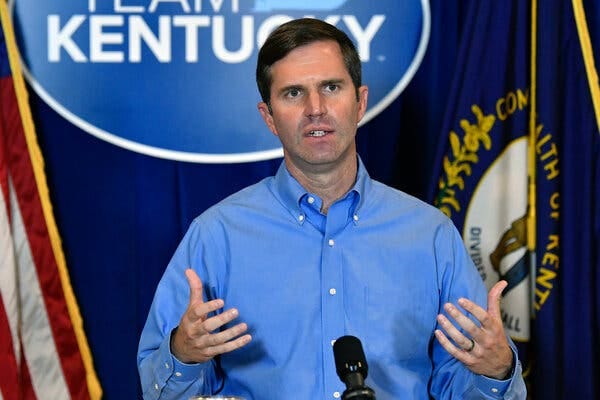

Gov. Andy Beshear said new restrictions were needed because of “exponential growth” in coronavirus infections in Kentucky. Credit…Timothy D. Easley/Associated Press
Kentucky will suspend all in-person instruction in elementary, middle and high schools beginning next week, ban indoor service at bars and restaurants and impose new limits on indoor gatherings, Gov. Andy Beshear announced on Wednesday, citing a steep rise in coronavirus cases and hospitalizations in the state.
“We are in the midst of exponential growth,” Governor Beshear said. “Our top five highest days ever in this virus of positive cases have all been in the last week.”
Kentucky joins a number of other states and cities that are imposing or reimposing restrictions as the virus rages out of control in much of the country.
Gov. Laura Kelly of Kansas announced a new statewide mask mandate on Wednesday. Gov. Tim Walz of Minnesota was expected to make an announcement Wednesday evening about new restrictions on fitness centers and indoor dining.
New York City said on Wednesday it was calling off in-person instruction in its public schools immediately, and officials in Denver said they would do so effective Nov. 30.
Kentucky reported 2,753 new coronavirus cases on Wednesday, a record, and hospitalizations for Covid-19 have risen by 40 percent in the last two weeks.
Middle and high schools in the state will not be allowed to resume in-person instruction until Jan. 4, 2021, the governor said. Elementary schools might resume as soon as Dec. 7, depending on conditions in each district. The suspension applies to both public and private schools.
Mr. Beshear said the ban on indoor restaurant and bar service and will take effect Friday and extend through Dec. 13. The state will set up a $40 million fund to help bar and restaurant owners with the financial repercussions, he said.
“This is not and will not be a shutdown,” he said. “Our economy is open.”
Private indoor gatherings in the state will be limited to eight people from no more than two different households, starting Friday, and indoor venues like movie theaters will be limited to 25 people, the governor said.
— Lucy Tompkins and Will Wright
Comments
Post a Comment